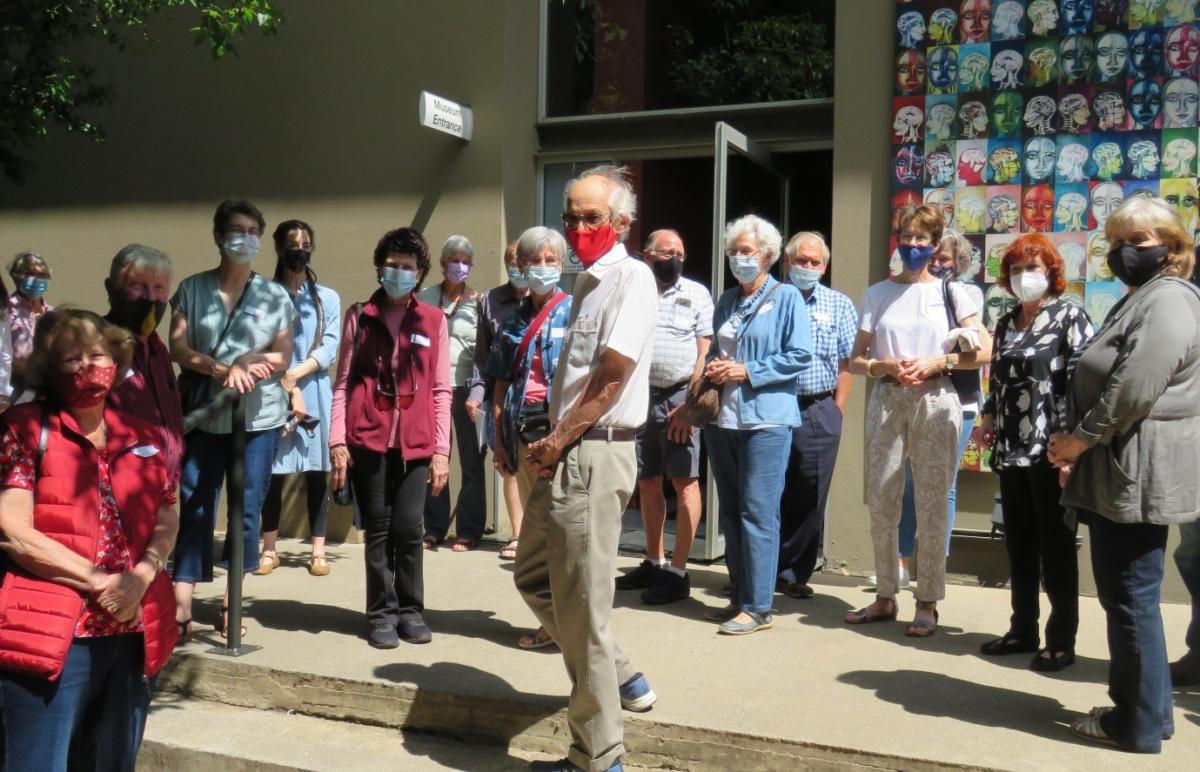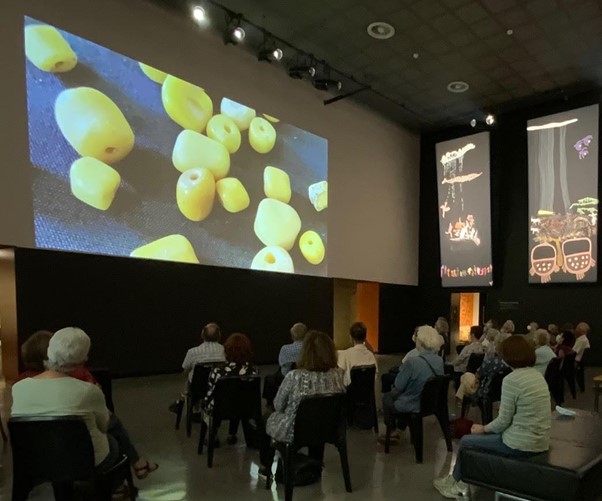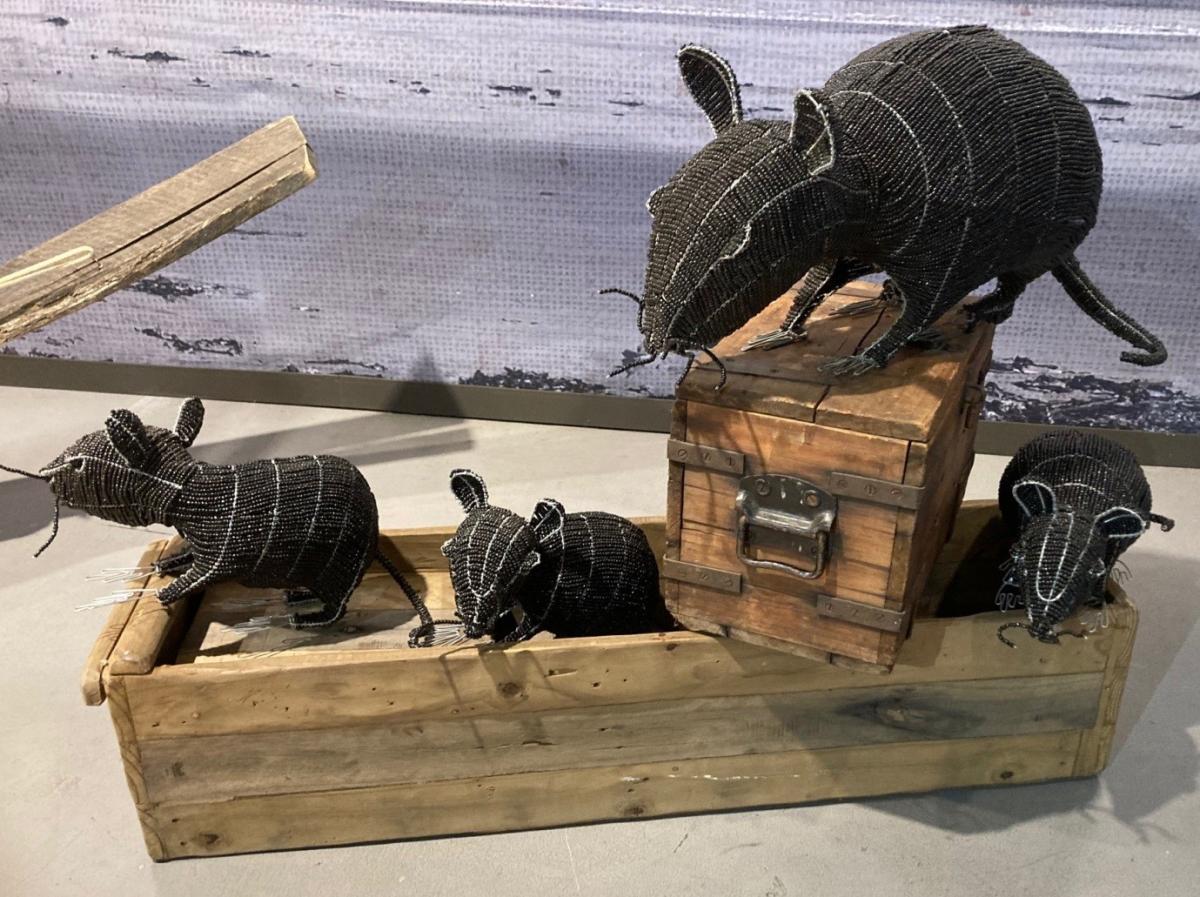Visit to two new exhibitions at the Wits Origins Centre
By:
John Wright
Date:
Sat, 20/11/2021 - 00:00
Branch:
Northern
The Origins Centre has recently opened two unmissable new exhibitions. One is titled ‘Origins of Early Homo Sapiens Behaviour’, while the other is ‘Navigating the Past through Glass Beads: Global Trade in Southern and Eastern Africa, 600 CE to the Present’. Two very different subjects, two equally absorbing – and beautifully curated – showcasings for anyone with an interest in the archaeological past.
Twenty-eight members of the Northern Branch – fully vaccinated and masked, as per instructions – were taken on a guided tour of the exhibitions. Our hosts were Mandy Esterhuysen, Associate Professor of Archaeology at Wits and Head of the Origins Centre, Tammy Hodgskiss Reynard, Curator at the Centre, and Jill Weintroub, Honorary Research Associate at the Centre.

Members of the tour gather at the entrance to the Origins Centre. (Photo SJ de Klerk)
Our three guides, together with Bongiwe Ndulula, Events Coordinator at the Centre, were responsible for curating the exhibition on ‘Navigating the Past’. It features a rich variety of beautiful beads from the archaeological collection at Wits, which contains beads recovered from sites in South Africa and also from countries like Egypt. Many of them have never been on public display before. In sharp contrast, the exhibition also features a number of imaginative works in beads that the Origins Centre commissioned from local artists – totally of the present, but highlighting features of the other displays.
The exhibition on early Homo sapiens behaviour was curated by Petro Keene of the Evolutionary Studies Institute (ESI) at Wits. It is based on thirty years of archaeological research in the southern Cape undertaken by Professor Christopher Henshilwood (of the ESI and the University of Bergen), Dr Karen van Niekerk (ESI) and Professor Sarah Wurz (Geography, Archaeology and Environmental Studies at Wits), and their research teams. The exhibition also features films by award-winning filmmaker Craig Foster. The displays focus on work done at Blombos Cave, Klipdrift Shelter and Klasies River, sites which were occupied by humans between 120 000 and 50 000 years ago. This period of what archaeologists call the Middle Stone Age is seen as a key period in the evolution of modern human behaviour.

A sample of beads from the Wits collection. Audience in rapt attention. (Photo Mandy Esterhuysen)
Our tour began with talks in the main lecture theatre by Mandy Esterhuysen and Jill Weintroub on the background to the bead exhibition. Mandy highlighted how archaeological evidence shows that southern Africa has been linked by land and sea to global networks of trade for at least 1400 years. Beads survive well in archaeological contexts, and finds have .been made in southern Africa of examples from as far afield as south-west Asia, India and China. Before 1500 the Africa end of the trade was in the hands of Muslim merchants based on the coast from southern Somalia to central Mozambique, and African intermediaries who traded luxury items inland in exchange for ivory and other animal products, gold and slaves. After 1500 much of the trade fell into the hands of European merchants-cum-pirates, first from Portugal and later from England and France.
Jill Weintroub, who confessed to having a love of beads and bead artwork, then told us the story of how the Wits bead collection had come into existence. It begins in the 1930s and 1940s with the work of Clarence van Riet Lowe, an engineer-turned-archaeologist who was appointed as the first head of South Africa’s official Archaeological Survey in 1935. Until his

Fellow travellers. Rats were among the unsolicited imports that arrived in Africa along with trade goods. The Origins Centre commissioned these bead models from Caitano Chikokoko, who hails from Zimbabwe and, originally, Mozambique. He learnt the craft from family members. (Photo Cara Pretorius)
retirement in 1954, he worked tirelessly, on top of all his other archaeological research, to build up the bead collection. In addition to items recovered from excavations in South Africa, the collection contains numerous beads that came into Van Riet Lowe’s hands through donations, solicited and unsolicited.
After the talks we were free to view the displays in our own time. It is impossible to do justice to them in the space of a brief report, but I can say that they are right up to date in the ways they have been conceived and put together. They use digital technology in imaginative ways to provide a feast of visual images, and are historically informative without being overloaded with detail. Go and see them for yourselves: you will not be disappointed.
John Wright.